 |

| |
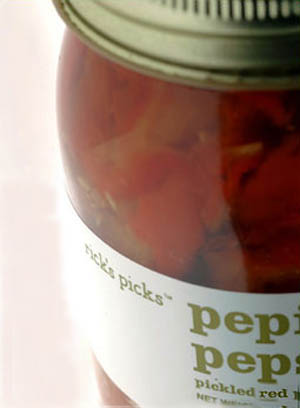
You’ll be pickled—or is that tickled?—pink with Rick’s Picks pickle portfolio. Pickled red peppers are only the beginning. |
| WHAT IT IS: Artisan-crafted pickled vegetables. |
| WHY IT’S DIFFERENT: Pickles—meaning pickled cucumbers—and other vegetables are transformed by gourmet brines to a higher plane. |
| WHY WE LOVE IT: Incredibly flavorful, almost no calories, no fat, and you can re-use the brine in everything from martinis to popsicles. |
| WHERE TO BUY IT: RicksPicksNYC.com. |
|
|
 |

Rick’s Picks Pickled Vegetables:
Peter Piper Picks Rick’s
Page 1: Overview
CAPSULE REPORT: With Rick’s Picks, you can pick a peck (or at least a 15-ounce jar) of pickled red peppers, asparagus, beets, green beans, green tomatoes, okra and, of course, that most familiar of pickled vegetables, the cucumber (including garlic dills, bread-and-butter and other pickles).
It was love at first bite with Rick’s Picks. We usually leave our specialty food store with arms aching, because we’re carrying so many jars. Rick’s, a beautiful artisan product, is no cheap pick(le), but it’s worth every nickel. Every sandwich served becomes more gourmet with a garnish of Rick’s Picks. A barbecue becomes memorable with a Rick’s Picks tasting bar. Some of the vegetables make cocktail garnishes extraordinaire. And as gifts for those who love their pickles, a sampler package—or even better, the Pickle Of The Month Club—will make you a hero.
We first wrote about Rick’s Picks two years ago. But Rick Fields continues to innovate (Smokra, pickled smoked okra, is a slam dunk—even for people who say they don’t like okra). With barbecue season, Father’s Day and summer guesting upon us, it’s time to revisit these gourmet pickles. There are four gourmet cucumber pickles and seven pickled vegetables for appetizers, sides, snacks and garnishes. You’ll never think of a pickle the same way again. In fact, you may even be inspired to try pickling your own! Read the full review below.
|
| |
|
|
THE NIBBLE does not sell the foods we review
or receive fees from manufacturers for recommending them.
Our recommendations are based purely on our opinion, after tasting thousands of products each year, that they represent the best in their respective categories. |
Pickle Your Own
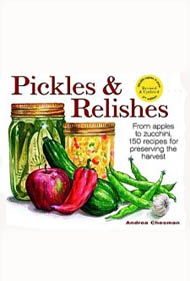 |
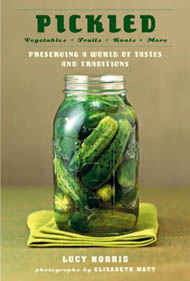 |
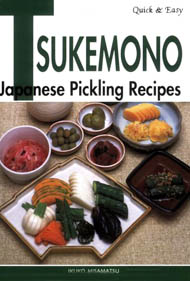 |
Pickles and Relishes: From Apples to Zucchinis, by Andrea Chesman. Learn how to make pickles, relishes and sauerkraut, including salt-free and quick-and-easy recipes. Even novice picklers will have fun putting up their first peck of pickles. Click here to purchase. |
Pickled—Vegetables, Fruits, Roots & More: Preserving A World Of Taste And Tradition, by Lucy Norris. Every cuisine has its pickle, and this book has 80 recipes for worldwide pickled delights. Make your own bread and butter pickles and cornichons! Click here to purchase. |
Quick & Easy Tsukemono: Japanese Pickling Recipes, by Ikuko Hisamatsu. Love those pickles at Japanese restaurants? Now, instead of paying big bucks for a few slices, you can make them at home, for family, guests and gifts. Click here to purchase. |
Rick’s Picks Pickled Vegetables: Peter Piper Picks Rick’s
INDEX OF REVIEW
|
MORE TO DISCOVER
|
Introduction
While the cucumber is native to India, cucumbers were probably first pickled 4,500 years ago in Mesopotamia, and were introduced around the world across trade routes. Cucumber pickling was known to the Ancient Greeks and Egyptians; by the second century B.C.E., pickling had reached China. Roman citizens valued pickled cucumbers as delicacies, and many different techniques were developed to pickle a variety of vegetables. Pickles spread, along with the Roman Empire, through the European continent.
Today, pickles can be found in virtually every cuisine. In Western European tradition, the pickling brine is often flavored with dill and garlic and a “pickle” generally refers to a pickled cucumber. In Korea, pickles refer to kimchi, the fiery pickled cabbage staple of Korean cuisine, heavily seasoned with garlic, chiles and in some cases, radish juice. Japanese pickles are usually an assortment of salty vegetables pickled in a soy brine. Some countries use sugar and fruit vinegar or wine vinegar for a sweeter pickle; some just add sugar.
With the artisan food movement, better pickles have been appearing on condiment shelves and in refrigerator cases. While better vinegar—and quality cucumbers* and spicing—will yield a better pickle, most of the artisan pickles we encounter are still versions of the classic dill variety—crisper, tastier sours and half-sours. We were tickled pink—or is that pickled pink—to discover Rick’s Picks gourmet pickles at our local farmers market. We have been happily munching on them for two years—sparingly, because they are a gourmet treat.
*Technically, a gherkin is not only a pickle of a certain size but also a particular species of cucumber—the West Indian or Burr cucumber (Cucumis anguria), which produces a somewhat smaller fruit than the garden cucumber (Cucumis sativus). Some gherkins are made from the West Indian cucumber, but most are made from the garden cucumber. And yes, the cucumber is technically a fruit, not a vegetable: its seeds are contained on the inside.
What Is A Gourmet Pickle?
As made by Rick Fields, a gourmet pickle eschews salt and sugar for a complex layering of fine spices and fresh herbs in a brine that imbues subtly dazzling tastes into the vegetables. And the best-quality vegetables, grown on small Hudson Valley and Catskills farms in upstate New York, are tossed into the drink to pickle away.
Rick’s Picks’ business office† is in the heart of New York’s Lower East Side, on Chrystie Street—the neighborhood of generations of pickle-makers who used to sell their products on the street. But Rick’s are not classic pickle-barrel pickles, fermented with vinegar, salt and water in big wooden barrels. Rick uses the hot-packing method, as home-picklers do, which requires heating the brine to 190 degrees. The brine and the vegetables are then placed in Mason jars, which are immersed in a hot water bath before sealing. The pickles—pickled cucumbers and other pickled vegetables—marinate away and are ready for consumption in a few weeks.
†The pickles are made in a facility in Poughkeepsie, New York, about an hour away from New York City.
|
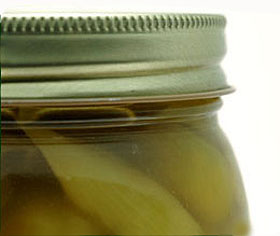
Windy City Wasabeans are green beans pickled in brine flavored with soy and wasabi. |
Continue To Page 2: Pickles & Pickled Vegetables
Go To The Article Index Above
Do you have friends who would enjoy THE NIBBLE?
Click here to send them an invitation to sign up for their own copy. |
© Copyright 2004-2025
Lifestyle Direct, Inc. All rights
reserved. All information contained herein is subject to change at any time
without notice. All details must be directly confirmed with manufacturers, service
establishments and other third parties. This material may not
be reproduced, distributed, transmitted, cached, or otherwise used, except with
the prior written permission of Lifestyle Direct, Inc.
|
 |

|
 |











